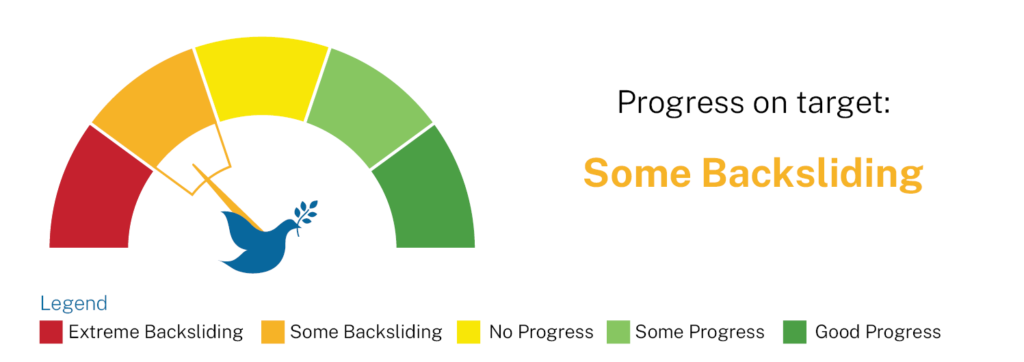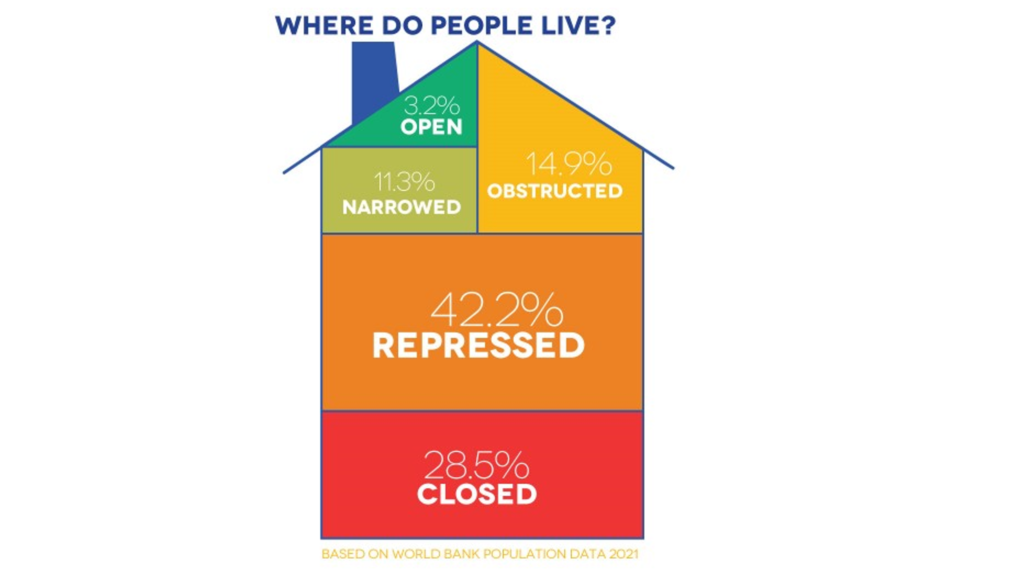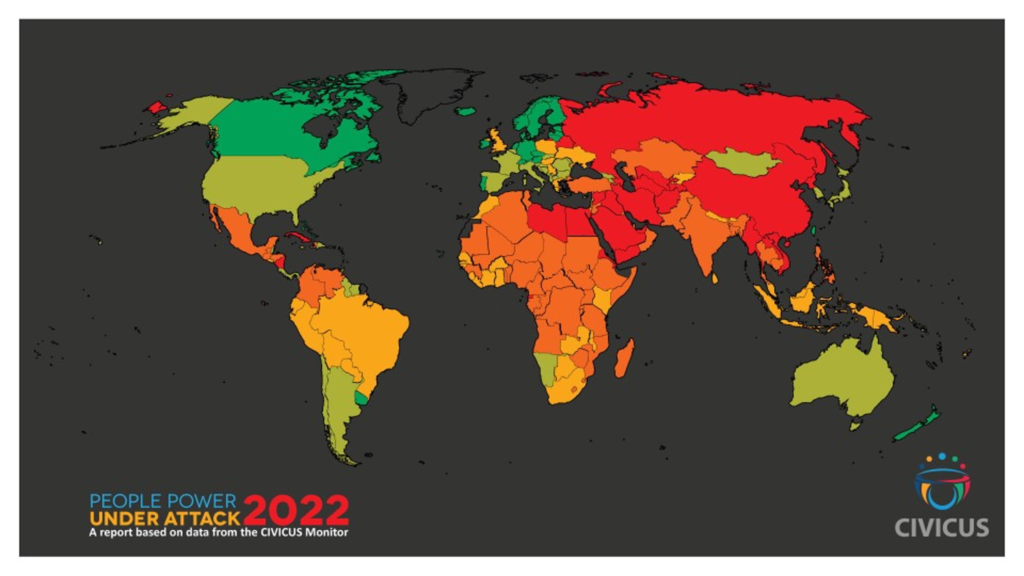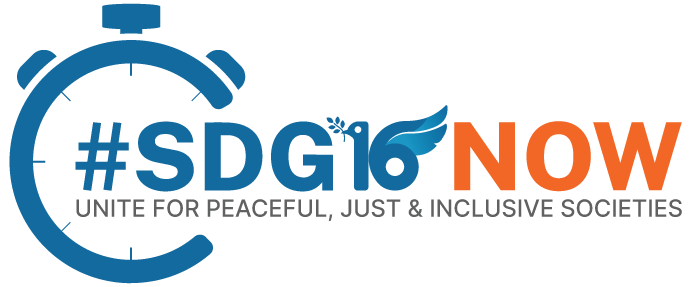Target 16.10: Ensure public access to information and protect fundamental freedoms, in accordance with national legislation and international agreements

Progress on Target 16.10 is heading backwards. According to official data, there are a high number of attacks on journalists and human rights defenders with serious gaps in reporting, while data from CSOs shows an increase in attacks on journalists, HRDs and trade unionists. At the same time, civic space has been substantially reduced in many countries. More positively, some countries have adopted new laws on access to information. But progress is too slow to meet the target, with indicators suggesting that progress on the implementation of laws has been backsliding.
Authors of chapter




Context and Interlinkages
Access to accurate information and voice opportunities, as well as respect for civic space and the creation of an enabling environment for Human Rights Defenders (HRDs), allows individuals to make informed decisions, to participate in decision making and to hold those in power accountable for their actions. As such, advancing Target 16.10 can help address the root causes of many of the world’s most pressing challenges, enabling progress towards all other SDGs. This includes poverty, unequal access to health care, economic backsliding and lack of quality employment, all of which are drivers of alienation and polarisation which, in turn, foster institutional mistrust. Ensuring that governments operate transparently – of which the adoption and implementation of access to information laws (Indicator 16.10.2) is a key component – is critical to the success of any form of public engagement which, in turn, is central to progress on every SDG goal and target. This indicator finds its roots in the basic principles of access to information, public participation and access to justice as set out in Principle 10 of the 1992 Rio Declaration.
SDG 16.10 connects closely with other SDG16+ targets such as homicides and conflict deaths (16.1), public participation (16.7) and transparent and accountable institutions (16.6). It’s also a key tool in fighting corruption and bribery (16.5) and illicit financial flows (16.4).
SDG 16.10 is also a key link between the 2030 Agenda and the broader international human rights framework. The UN Secretary-General in his 2020 Call to Action for Human Rights, called for human rights principles to inform implementation of the 2030 Agenda, including empowering people and creating avenues for civil society participation. As protected international human rights, public access to information and the protection of fundamental freedoms are important, both of themselves, and as key underpinnings of accountability, participation, good governance and sustainable development. The Danish Institute for Human Rights (DIHR) has found links to Target 16.10 in over 17 international and regional human rights instruments.1
Progress on indicators
Official indicators:
- 16.10.1: Number of verified cases of killing, kidnapping, enforced disappearance, arbitrary detention and torture of journalists, associated media personnel, trade unionists and human rights advocates in the previous 12 months; (Tier I)
- 16.10.2: Number of countries that adopt and implement constitutional, statutory and/or policy guarantees for public access to information (Tier II)
Additional Indicators:
- CIVICUS Monitor
Attacks on and killings of key civil society actors (16.10.1) is grim and worsening. The UN reports over 300 journalists, human rights defenders, and trade unionists are killed every year, without any signs of that number diminishing.2 According to CSOs, killings of human rights defenders have been increasing substantially since the 2030 Agenda was adopted. Front Line Defenders reported that 401 human rights defenders were killed in 26 countries in 2022, 80 per cent in just five countries – Colombia, Ukraine, Mexico, Brazil and Honduras.3 This is up from 156 reported killed in 2015. According to Global Witness, over 1,700 environmental and land defenders have been killed in the past decade, averaging around 200 per year.4 The number of killings of journalists, as monitored by UNESCO and leading civil society groups, has declined somewhat since 2015, in part due to the fact that some of the most severe conflicts around the world have either ended or diminished substantially in intensity. Trade unionists were murdered in thirteen countries in 2022, compared with six in 2021.5
Other issues in the target – kidnapping, enforced disappearance, arbitrary detention and torture – are not officially reported. Out of 162 countries which have submitted Voluntary National Reviews (VNRs) between 2015 and 2021, only three, or around 2 per cent, reported at least one attack or killing of a human rights defender. Seven, or around 4 per cent, reported no cases at all, while 94 per cent of countries did not report on 16.10.1 at all.6
A key problem here is the lack of attention given by governments to monitoring and reporting on these indicators. Moreover, research shows that because of varied capacity and available information, there is a lack of regular and systematic monitoring of these issues at national and regional levels.7 In terms of human rights defenders specifically, the data available at the global level is limited and it is not disaggregated to indicate the differing situations of, for instance, land, environmental and indigenous human rights defenders.
Civil society reporting shows dangerous trends for these issues. According to the Committee to Protect Journalists, the number of journalists who are imprisoned has been rising steadily since 2015, with 2022 bearing the highest number on record at 363 imprisoned journalists – a 65 per cent increase since the adoption of the 2030 Agenda.8 The Business & Human Rights Resource Centre reported 555 attacks on human rights defenders in 2022, 4,700 in total since 2015.9 In 2022, 44 per cent of countries detained and arrested workers, often trade union leaders, compared to 25 per cent in 2014.10 Violent attacks on trade unionists increased from 29 per cent to 34 per cent of countries in the same period.
In terms of access to information (16.10.2), 138 countries had adopted laws or policies on access to information by the end of 2022, but progress has been slowing. About one-quarter of the 96 countries which had not adopted laws by September 2015 had done so by September 2022. Only two countries adopted laws in 2022. If the aim were for 75 per cent of the 96 countries to adopt laws by 2030, the target would not be reached at the current rate of progress.
A greater problem exists with implementation. While no widespread, central assessment of implementation of these laws has been conducted so far, “there is a lot of anecdotal evidence about implementation challenges”.11


Source for both: Centre for Law and Democracy
A similar problem – the lack of VNR reporting – applies to reporting on Indicator 16.10.2. UNESCO, the custodian agency for this indicator, has developed a rather limited eight-question self-assessment survey, of which the adoption and content of laws is the subject of the first five questions. This information is already publicly available through non-official data, specifically the Right to Information (RTI) Rating, which provides an in-depth assessment of the legal framework for access to information in each country which has adopted a law.12 As noted above however, a widely applied tool to assess implementation of these laws does not yet exist, with implementation being complex matter which is the subject of only three questions in the UNESCO survey.
As such, official reporting on the ‘official’ indicators for Target 16.10 does not give us a comprehensive understanding of what progress is being made towards them. On the other hand, non-official data, which is more robust and reliable, suggests that progress is limited.
Additional Indicators
There are serious problems with relying on Indicator 16.10.1 as a surrogate measurement for the very broad issue of protecting fundamental freedoms, the aspect of Target 16.10 to which it relates. It is not inconsequential to assess cases of killings, kidnappings, enforced disappearances, arbitrary detention and the torture of journalists, trade unionists and human rights advocates. However, this covers only the most severe violations and does not track a wider range of infringements, including physical assaults, threats, intimidation, harassment, exile and digital attacks.
For example, reports by the Council of Europe13 and UNESCO14 have emphasised that gender-based violence and harassment, especially online, are more commonly used to intimidate and silence female and non-binary journalists. Female journalists are also frequently targeted by coordinated disinformation campaigns which utilise various techniques – such as deep fakes, hacked photos and rumours of misconduct – to undermine the target’s credibility and reputation. Such targeted harassment curtails the participation of female journalists in public discourse. This, in turn, has a sinister effect on freedom of expression and gender equality goals. None of this is captured by Indicator 16.10.1.
This indicator also ignores the many other ways fundamental freedoms can be undermined beyond physical attacks and harassment, such as through repressive legal frameworks. It also fails to assess measures to prevent and remedy violations of freedoms. Civil society organisations have called for an expansion of Indicator 16.10.1 to account for other ways in which freedom of expression, access to information and the freedoms of journalists and human rights defenders are restricted; for example, to include stigmatising discourse, criminal and civil legal processes, and internet restrictions as “other harmful acts”.15
According to the CIVICUS Monitor – a research collaboration between over twenty organisations from around the world to measure fundamental civic freedoms of peaceful assembly, association and expression – civic freedoms are being curtailed in a growing number of countries, with civil society facing severe attacks in 117 of 197 countries and territories, an increase from 111 in 2018.16 Global findings released in March 2023 reveal that only 3.2 per cent of the world’s population live in 38 countries or territories with ‘open’ or enabling civic space conditions. Conversely, 28 per cent of the world’s population live in 27 countries or territories with ‘closed’ civic space conditions where the mere exercise of democratic dissent, or posing questions to those in power, can result in imprisonment, forced exile or death. Most recently governments have used the COVID-19 pandemic as a pretext to further restrict fundamental freedoms, including the right to protest. Despite this, people are continuing to mobilise, including by using creative and alternative forms of protest when pandemic restrictions are applied, such as masked and distanced demonstrations and online protests. Technology has broadened the opportunities for mobilising, but at the same time, new challenges have emerged for critical voices, as governments expand their tactics to restrict online access and put people under surveillance.

Source: CIVICUS Monitor
Among the top violations of civic freedoms recorded globally in 2022 are: harassment and intimidation of activists, journalists and civil society organisations, to deter them from carrying out their human rights work; arbitrary detentions of protesters as punishment for speaking out against those in power; and restrictive laws designed to prevent people mobilising and exercising their fundamental civic freedoms.

Source: Civicus
Recommendations
- Governments should create an enabling environment for civil society activists and journalists to operate freely without fear of harassment, intimidation, attacks, or reprisals, including by:
- Repealing any legislation that unduly criminalises HRDs, protesters, journalists and members of excluded groups. Additionally, by ensuring that adequate consultations are carried out with the public and civil society and that their input is taken into account before drafting laws that have an impact on civic space.
- Carrying out independent, prompt and impartial investigations into all cases of attacks on and killings of HRDs and journalists, and ensuring those responsible are brought to justice.
- Adopting and properly implementing access to information laws which are in line with international standards in this domain.
- The UN should pressure states to repeal or substantially amend restrictive legislation which is not in accordance with international law and standards in protecting freedoms of association, peaceful assembly and expression.
- States should make a far greater effort to collect reliable data on progress on Indicators 16.10.1 and 16.10.2 and to report regularly and accurately based on this data.
- Civil society organisations should continue to play a significant role in providing non-official data on both Target 16.10 indicators, including by tracking various forms of violations against journalists and human rights defenders, by maintaining the RTI Rating on access to information laws and by expanding their assessment of implementation of these laws.
- Beyond collecting and reporting on the information set out in Indicator 16.10.1, both states and civil society should report on a wider scope of violations of fundamental freedoms to account for the various ways in which they are restricted. This should include the following elements:
- Reporting should not only cover the severe violations listed in this indicator but also other violations, including various forms of online violence.
- Data for this indicator should be disaggregated, including along gender- and minority-status lines and by type of human rights defender involved. Reporting should also highlight the special risks faced by these different groups.
- Reporting should go beyond attacks and cover more structural barriers and related human rights gaps to the enjoyment of fundamental freedoms, such as the legal framework and absence of a proper enabling environment.
Case Study: Right to Defend Rights
To strengthen monitoring of Indicator 16.10.1 and to provide more nuanced data, the Danish Institute for Human Rights, in cooperation with UN OHCHR and an expert reference group of 20 organisations and institutions, has developed an online assessment tool, the Right to Defend Rights.17 In addition to curating data relating to Indicator 16.10.1, it helps identify structural barriers and related human rights gaps to creating a safe, enabling environment for human rights defenders.
National Human Rights Institutions (NHRIs) play an important role in promoting and monitoring an enabling environment for HRDs. NHRIs formalised their goals of improving the collection of data on violations against human rights defenders in 2018 when the Global Alliance of National Human Rights Institutions (GANHRI) adopted the Marrakech Declaration. Through the Declaration, GANHRI members committed to: “Monitor and report on civic space – online and offline – though the collection and analysis of disaggregated data, including gender-based disaggregation and statistics related to killings, fabricated legal charges, misuse of specific laws and other attacks against human rights defenders, journalists and trade unionists, lawyers, students, academics, in line with SDG indicator 16.10.1”.18
Case Study: The Escazu Agreement’s ups and downs
The ‘Escazu Agreement’ is commonly presented as an environmental agreement of Latin America and the Caribbean, but it is much more than this. The official title of the treaty is ‘Regional Agreement on Access to Information, Public Participation and Justice in Environmental Matters in Latin America and the Caribbean’, making clear that it relates to issues beyond a classical approach to environmental protection and management.
The Agreement addresses access rights to information, public participation, and justice in matters such as sustainable use of natural resources, biodiversity conservation, the fight against land degradation, climate change, and disaster-risk reduction. Moreover, it includes the world’s first binding provision on human rights defenders in environmental matters in a region where they are regularly subject to attacks, from intimidation to killings.
The treaty came into effect in April 2021. However, only 25 of the 33 countries of the region have signed it, and only 15 have ratified it so far. Following a promising start, Escazu is now confronting increased opposition from countries refusing to become part of the agreement, including Costa Rica (with its good reputation in democracy, human rights, and environment protection), El Salvador, Peru, and Honduras. In Brazil, Bolsonaro rejected the treaty, and Lula’s victory in the recent elections placed a question mark over its implementation in the country.
Business opportunities and sovereignty are the reasons argued for those against the Escazu Agreement ratification, but protecting nature and people should be a priority for any business and the basis of any sovereignty claim.
Case Study: Museums and libraries as spaces for dialogue and information literacy
Latvia’s 2022 VNR highlighted the transformative potential of museums and libraries, to progress sustainable development and the SDGs. The VNR includes case studies from a wide range of museums and libraries covering all 17 SDGs. Latvia’s side event for the High-Level Political Forum was titled ‘Libraries and Museums as Safe Spaces for Dialogue and Information Literacy’, in the context of misinformation. Latvia’s VNR notes that the role of Latvian museums and libraries as an inclusive, safe space for visitors to learn about, and understand sustainable development, has grown significantly over the last three years thanks to the professional training of museum workers and librarians on the SDGs, as well as due to regional cooperation. Actions taken include: creating and documenting museum and library activities; the establishment and maintenance of shared databases; the sharing of best practices through international networks and expert groups; and participating in and taking responsibility for the preparation of international reports. Latvia’s experience may be useful to libraries and museums in other countries. Cultural heritage, in turn, strengthens sustainability and provides an impetus for sustainable action, for example, by promoting a circular economy.19

Resources
- RTI Rating
- RTI Evaluation
- SDG 16 Data Initiative: Impact of the pandemic on measuring progress towards SDG 16: Looking forward, tackling obstacles
- SDG Data Initiative: Are we on track to meeting the 2030 agenda?
- Free Press Unlimited: Toolkit Shadow Reporting on SDG 16.10
- IFLA: Development and Access to Information
- ICCROM: Our Collections MATTER, resources on SDG 16. SDG 16: Peace, Justice and Strong Institutions
